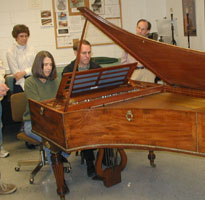1816 Fortepiano Is Restored, Rededicated, and Available for Student and Faculty Use
 In April 2006 the department hosted a dedicatory concert for the newly restored fortepiano.
In April 2006 the department hosted a dedicatory concert for the newly restored fortepiano.
The concert was held Saturday evening, April 22, at the Williamsburg Regional Library Theatre, and featured a performance by Malcolm Bilson, the Frederick J. Whiton Professor of Music at Cornell University and one of the foremost fortepianists in the world.
In addition to enthralled campus and community music-lovers, the audience included members of the Capitol Chapter of the American Musicological Society and attendees of the second biennial conference of the Society for Eighteenth-Century Music. Afterward, audience members exclaimed over the "truly special performance" and the marvelous and rare experience of hearing a fine musician play such a beautiful and historic instrument.
The fortepiano is the precursor to the modern piano (it is very different from a harpsichord); this particular instrument was built by the renowned firm of John Broadwood in London in 1816 - the same year as Beethoven's Broadwood. Even more remarkable is the well documented Virginia lineage of the instrument. It was ordered by the Skipwith family of Meckelenberg County, Virginia, was built in London, shipped across the Atlantic, and arrived at the family's home of Prestwould Plantation, on the Roanoke River, where it remained throughout the nineteenth century.
The instrument was donated to the College in 1946, and was stored in the Botetourt Gallery of Swem Library for decades. The major drawback to this jewel of an instrument - at least as far as the Department of Music was concerned - was that by the 1970s it was completely unplayable. It was an historic curiosity, but could no longer be used to make music.
Tom Marshall, harpsichordist and keyboard specialist in the Department of Music, had for many years championed the idea that the instrument should be restored. The Department eventually embarked on the ambitious goal of raising the $20,000 necessary to do so. The goal was met surprisingly quickly, thanks to the generous help of the Office of the Dean, Arts and Sciences; the Christopher Wren Association; the men of Phi Mu Alpha Sinfonia; and in particular the women of Nu Kappa Epsilon, who raised 10 percent of the needed funds by holding several benefit concerts.
In June 2001, the Department of Music contracted with the Colonial Williamsburg Foundation to have the restoration undertaken by its Instruments Conservator, John Watson, an expert on the restoration of early keyboard instruments. Watson was both familiar with the Skipwith piano and eager to restore it to playing condition. He completed work on the instrument in late 2004, and in the process transformed the Skipwith piano into what he described as "the most important keyboard instrument of this vintage in the Southeast."
The Skipwith piano - a priceless nineteenth-century Virginia historic artifact that is now a treat for both the eyes and the ears - is being stored at the DeWitt Wallace Gallery of the Colonial Williamsburg Foundation until a secure, climate-controlled facility is available on campus. The instrument will be on display to the general public. It will also be accessible to William and Mary students under faculty supervision, and will be featured in special concerts in the future.
 Skip to main content
Skip to main content
